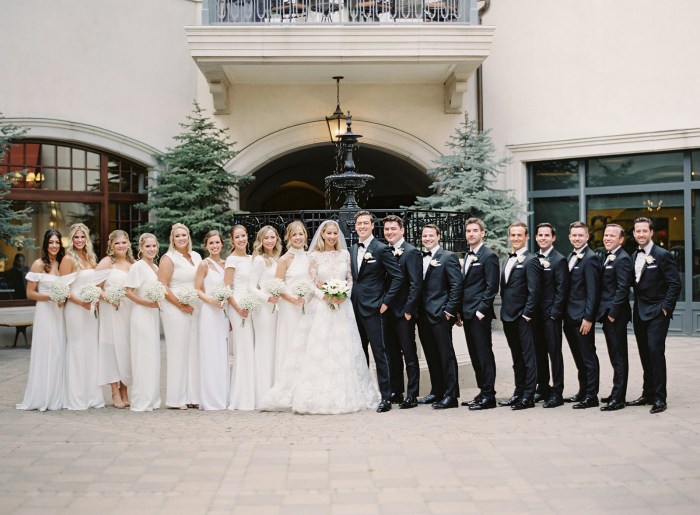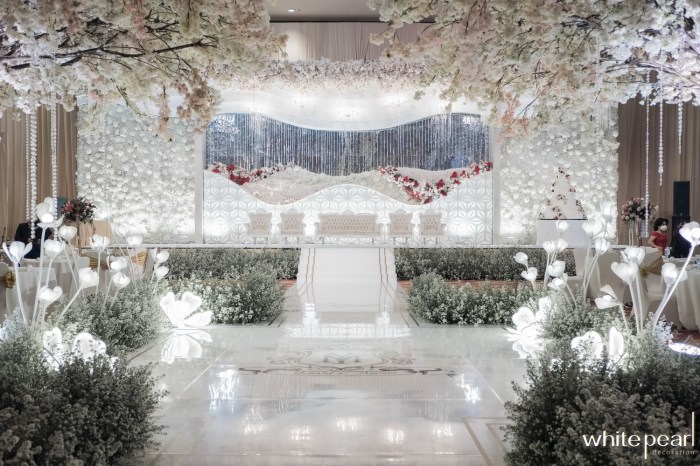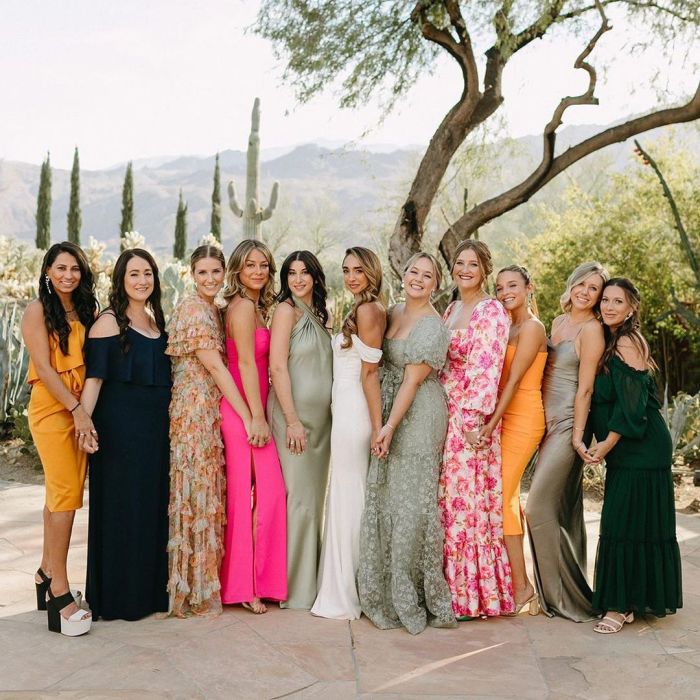Types of White Wedding Dresses
White dress for wedding – Choosing a wedding dress is a significant step in wedding planning. The style of dress significantly impacts the overall look and feel of the wedding. Understanding the various types available helps brides find the perfect silhouette to flatter their figure and complement their personal style.
White Wedding Dress Styles
Several classic and contemporary styles cater to diverse preferences. Each style offers unique characteristics in silhouette, neckline, and sleeve options.
- A-Line: This universally flattering silhouette is fitted at the bodice and gradually flares out from the waist, resembling the letter “A.” It’s versatile, accommodating various necklines (e.g., sweetheart, V-neck, halter) and sleeve lengths (e.g., sleeveless, short sleeves, long sleeves).
- Ballgown: Characterized by a fitted bodice and a full, voluminous skirt, the ballgown creates a dramatic and princess-like look. It often features a structured skirt made of layers of tulle or other fabrics. Necklines can vary widely, from simple to elaborate.
- Mermaid/Trumpet: This style hugs the body closely from the shoulders to the knees or mid-thigh, then flares out dramatically, creating a fishtail effect. It’s best suited for brides who want to show off their figure. Necklines and sleeve styles are versatile.
- Sheath: A simple and elegant choice, the sheath dress is fitted from the shoulders to the hem, creating a sleek and streamlined silhouette. It’s ideal for brides who prefer a minimalist aesthetic. Necklines are typically simple and clean.
- Empire Waist: This style features a high waistline just below the bust, creating a flowing skirt that falls loosely from the empire line. It’s often chosen for its flattering effect on various body types. Sleeves and necklines are highly adaptable.
Wedding Dress Fabrics
The fabric significantly impacts the drape, texture, and overall look of the dress. Understanding fabric properties is crucial for choosing a comfortable and aesthetically pleasing gown.
- Satin: Known for its luxurious sheen and smooth texture, satin creates a sophisticated and elegant look. It’s relatively easy to care for but can be prone to wrinkling.
- Lace: A timeless choice, lace adds a touch of romance and intricate detail. It comes in various patterns and weights, offering diverse levels of formality and coverage.
- Tulle: A lightweight, sheer fabric, tulle is often used to create volume in skirts and overlays. It’s delicate and requires careful handling.
- Chiffon: A lightweight, flowing fabric, chiffon creates a soft and romantic look. It drapes beautifully but can be more delicate than other fabrics.
Wedding Dress Styles and Body Types, White dress for wedding
The ideal dress style depends heavily on body type. Choosing a style that accentuates positive features while minimizing concerns is key.
| Dress Style | Body Type | Pros | Cons |
|---|---|---|---|
| A-Line | Most body types | Flattering, versatile, comfortable | Can be less dramatic than other styles |
| Ballgown | Hourglass, pear | Creates a dramatic look, hides lower body | Can be overwhelming for smaller frames |
| Mermaid | Hourglass, athletic | Shows off curves, creates a dramatic silhouette | Can be uncomfortable for some, not suitable for all body types |
| Sheath | Athletic, slender | Sleek, modern, comfortable | May not be flattering for curvier figures |
| Empire Waist | Most body types, especially apple or pear | Flattering on various body types, comfortable | Can be less defined at the waist |
Finding the Perfect White Wedding Dress
The process of finding the perfect wedding dress involves careful consideration of various factors and a methodical approach to ensure a positive experience.
Factors to Consider When Choosing a Wedding Dress
Several crucial elements should guide your selection process to ensure the dress aligns with your vision and the overall wedding aesthetic.
- Venue: A formal ballroom calls for a more elaborate gown than a beach wedding.
- Season: Lightweight fabrics are ideal for summer weddings, while heavier fabrics are suitable for winter.
- Personal Style: Choose a dress that reflects your personality and makes you feel confident and beautiful.
- Budget: Set a realistic budget and stick to it. Consider alterations costs as well.
The Wedding Dress Shopping Process
Finding your dream dress involves exploring various options and approaches to suit individual preferences and circumstances.
- Bridal Boutiques: Offer personalized service and expert advice, allowing for try-ons and consultations.
- Online Retailers: Provide a wider selection and often lower prices but lack the personalized experience of boutiques.
- Custom Design: Allows for complete control over the design and fit but is more expensive and time-consuming.
A Step-by-Step Guide to Wedding Dress Fittings

Source: callunaevents.com
A well-structured approach to fittings ensures the best possible fit and overall experience.
- Schedule appointments in advance: Boutiques often book up quickly.
- Bring supportive undergarments: This ensures accurate sizing and fit.
- Bring trusted companions: Their opinions can be helpful but avoid bringing too many people.
- Pay attention to comfort and fit: The dress should feel comfortable and move well.
- Don’t rush the decision: Take your time and consider all options before making a final choice.
Accessorizing a White Wedding Dress: White Dress For Wedding
Accessories play a vital role in enhancing the overall look and feel of a white wedding dress, allowing for customization and personalization.
Accessories to Complement a White Wedding Dress
A variety of accessories can be used to elevate the bridal look and reflect the chosen style.
- Veils: From cathedral-length to birdcage veils, they add a touch of elegance and tradition.
- Jewelry: Necklaces, earrings, and bracelets can enhance the overall aesthetic, depending on the neckline and dress style.
- Shoes: Heels, flats, or sandals can complement the dress and add to the overall look.
- Headpieces: Tiaras, floral crowns, or hair combs add a touch of glamour or a bohemian feel.
Transforming the Look with Accessories
Accessories can significantly alter the overall style of a white wedding dress, creating different moods and aesthetics.
- A minimalist look: A simple sheath dress with delicate earrings and a small veil creates a clean and modern feel.
- A romantic look: A lace ballgown with a long veil, floral crown, and delicate jewelry creates a dreamy and romantic feel.
- A bohemian look: A flowing A-line dress with a flower crown, layered necklaces, and ankle boots creates a relaxed and free-spirited feel.
Three Distinct Wedding Dress Looks
Here are three examples illustrating the transformative power of accessories.
- Classic Elegance: A simple A-line satin gown paired with a long, flowing veil, pearl earrings, and elegant heels creates a timeless and sophisticated look. The inspiration is classic Hollywood glamour.
- Modern Minimalist: A sleek sheath dress with a subtle train, minimal jewelry (perhaps a delicate pendant necklace), and simple pointed-toe heels creates a clean and contemporary aesthetic. The inspiration is modern architecture and design.
- Romantic Bohemian: A flowing chiffon gown with intricate lace detailing, a floral crown, layered necklaces, and ankle boots creates a relaxed and whimsical feel. The inspiration is nature and free-spirited bohemian style.
White Wedding Dress Maintenance and Care
Proper care and maintenance ensure the longevity and beauty of your wedding dress, preserving it as a cherished keepsake.
Choosing the perfect white dress for your wedding is a significant decision, impacting your overall look and comfort. A crucial element often overlooked is what lies beneath; consider checking out this helpful guide on what to wear under your wedding dress to ensure a flawless fit and feel. Ultimately, the right undergarments can make all the difference in how your white dress looks and feels throughout your special day.
Cleaning and Care Methods for Wedding Dress Fabrics
Different fabrics require different cleaning methods to maintain their quality and appearance.
- Satin: Spot clean gently and avoid harsh chemicals. Professional dry cleaning is recommended.
- Lace: Handle with care to avoid damage. Professional dry cleaning is generally preferred.
- Tulle: Delicate and prone to snags, professional dry cleaning is recommended.
- Chiffon: Handle with care. Professional dry cleaning is recommended.
Storing a Wedding Dress After the Wedding
Proper storage is crucial to prevent damage and maintain the dress’s condition.
- Use an acid-free garment bag: This protects the dress from dust and light.
- Store in a cool, dry place: Avoid areas with extreme temperatures or humidity.
- Avoid direct sunlight: Sunlight can fade the fabric.
Professional Dry Cleaning vs. At-Home Cleaning
Choosing between professional and at-home cleaning depends on the fabric and the bride’s comfort level.
- Professional Dry Cleaning: Offers specialized care and expertise, ensuring the dress is cleaned properly and safely. It’s more expensive but provides peace of mind.
- At-Home Cleaning: Can be cost-effective but may risk damaging the delicate fabric if not done properly. Only attempt if you are confident and have the necessary skills and supplies.
Illustrative Descriptions of White Wedding Dresses
These descriptions illustrate the diverse possibilities in white wedding dress design, showcasing different styles and aesthetics.
Classic Elegant White Wedding Dress
Imagine a timeless A-line gown crafted from luxurious ivory satin. The bodice features delicate, hand-beaded lace appliqués that cascade down the skirt, creating a subtle shimmer. A sweetheart neckline accentuates the collarbone, while long, flowing sleeves add a touch of romance. The skirt falls gracefully to the floor, creating a classic silhouette. The overall effect is one of refined elegance and timeless beauty.
Modern Minimalist White Wedding Dress

Source: bridestory.com
This sleek sheath dress is crafted from crisp white crepe, creating a clean and modern silhouette. The high neckline and long sleeves provide a sophisticated look, while the subtle train adds a touch of drama. The dress is devoid of embellishments, relying on the fabric’s inherent elegance to make a statement. The overall effect is one of understated chic and contemporary style.
Romantic Bohemian White Wedding Dress
Picture a flowing A-line gown made from delicate ivory lace and soft chiffon. The bodice features delicate floral embroidery, while the skirt is adorned with layers of sheer tulle, creating a romantic and ethereal effect. The dress features a relaxed fit, allowing for effortless movement and a free-spirited feel. The overall effect is one of whimsical romance and bohemian charm.
Clarifying Questions
Can I wear ivory if I’m not the bride?
Ivory is generally acceptable for guests, but it’s best to avoid anything too close to white to avoid upstaging the bride.
How far in advance should I start looking for a wedding dress?
Ideally, start searching 9-12 months before your wedding to allow ample time for alterations and potential delays.
What should I wear to a wedding dress appointment?
Wear comfortable undergarments similar to what you plan to wear under your dress. Consider nude-colored underwear and simple shoes.
How much should I budget for alterations?
Budget at least 10-15% of the dress cost for alterations. This can vary greatly depending on the complexity of the alterations needed.

